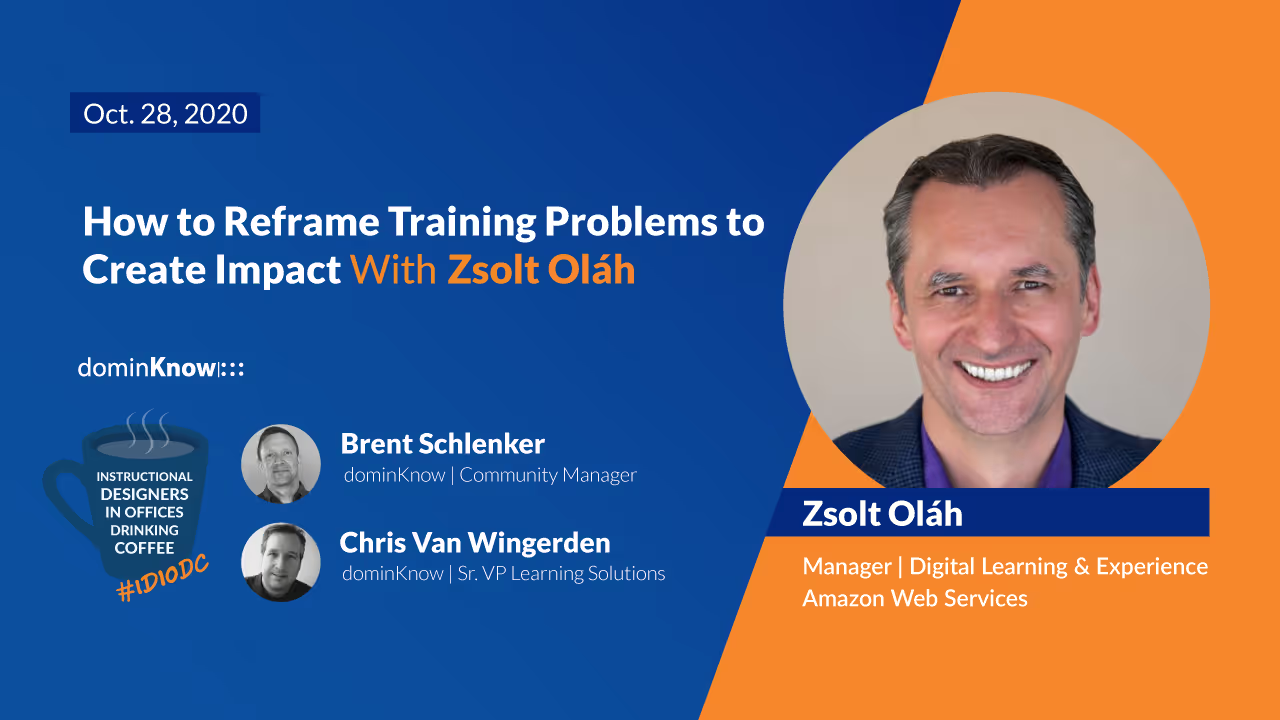This week our guest Zsolt Oláh presented his thought process, or technique, for reframing training problems. The is something we talk about often, but Zsolt’s acronym will help us put that thinking into practice.
REFRAME is an acronym that helps you think more deeply about the reasons why training is being requested:
- [R] ethink the request
- [E] ngage the right people
- [F] ocus on the why
- [R] ephrase the problem
- [A] ssume nothing
- [M] ake lots of bad ideas
- [E] xplore potential solutions
The concept of reframing is a technique that comes from psychology -- helping people solve problems through reframing their thought processes.
Before you jump into your authoring tool. Stop! Think about the problem you are trying to solve. Ask yourself and your stakeholders, “How do we know this is really a problem?” Once you have that answer you have already started the process of reframing the problem.
Zsolt’s speeding ticket analogy works perfectly.
If your main goal is to reduce the number of speeding tickets, then one answer might be just not giving out as many tickets. Or maybe simply remove the speed limits completely and let people drive as fast as they need too.
Let that sink in for a minute...
You might be rolling your eyes and instantly thinking, “Well, that’s obviously not a solution.”
But what you may not realize is that reframing of the question leads to the TRUE problem that needs to be solved: the number of accidents.
And now you have an entirely new, and bigger problem, with a new set of questions to answer. Because would you really need a speed limit if you had ZERO traffic accidents?
Some attendees in the chat made connections to other processes like continuous improvement techniques within manufacturing, design thinking, and the consultative process.
Here’s a couple questions that were asked in the Question forum of the session:
- I have found that identifying the right stakeholders is an issue and particularly when you are using human centric design mechanisms. Thoughts about how to engage stakeholders that are decision-makers and also stakeholders that are users?
- How do you use REFRAME with CREAM?
You can view the full archive recording which includes the chat comments here.
About Zsolt Oláh
Zsolt is a Manager, Digital Learning & Experience at Amazon Web Services (AWS) World Wide Public Sector. His focus is on accelerating skills development by simplifying finding the right learning content and amplifying its efficiency of application on the job. Prior to Amazon, Zsolt worked as a learning consultant at Kineo helping clients solving technology-related business problems through learning and performance support. These projects often included stakeholder and root cause analysis, learning persona creations, action mapping, and architecture design.
Before Kineo, as Director of Innovation and Learning Solutions, Zsolt led a team of instructional designers, graphic designers, and developers at the Performance Development Group to create innovative learning solutions. Zsolt is a frequent speaker at national and international conferences and author of the book, Engage the WORL&D!. He regularly publishes articles on elearningindustry.com, where he was listed as one of the top 10 thought leaders in 2019. Beyond solving learning and performance problems, Zsolts love games, soccer, storytelling, and screenplay writing. His last screenplay was a finalist in an international screenplay writing competition.
Connect with Zsolt on LinkedIn.
About IDIODC
Instructional Designers in Offices Drinking Coffee (affectionately known as IDIODC) is a weekly live videocast and podcast that helps instructional designers with pain points and provides best practices and industry insight.
Every Wednesday morning at 10am ET hosts Brent Schlenker and Chris Van Wingerden guide us through an upbeat and candid conversation with their guests from the elearning and training world. The live cast session encourages peers to participate in the chat and share their own personal insight! After airing live, you can catch the learning podcast on all major streams such as Spotify, Apple and Google Play podcasts, as well as on YouTube.



.svg)









